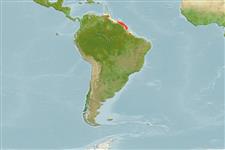>
Ophidiiformes (Cusk eels) >
Ophidiidae (Cusk-eels) > Ophidiinae
Etymology: Lepophidium: Latin, lepus, leporis = rabbit + Greek, ophis = serpent (Ref. 45335); collettei: Named for Bruce B. Collette..
Environment: milieu / climate zone / depth range / distribution range
Ecologie
marien demersaal; diepte 7 - 66 m (Ref. 91765). Tropical; 12°N - 1°S, 64°W - 45°W (Ref. 91765)
Western Atlantic: Shelf waters off the mouth of the Amazon and along the Guianan coast to the Gulf of Paria between Trinidad and Venezuela.
Grootte / Gewicht / Leeftijd
Maturity: Lm ? range ? - ? cm
Max length : 16.4 cm SL mannelijk / geslacht onbekend; (Ref. 91765)
Korte beschrijving
Morfologie | Morfometrie
Dorsale zachte stralen (totaal): 116-122; Anale zachte stralen: 96 - 103; Wervels: 65 - 69. This species can be distinguished from all its congeners on the basis of vertebral counts (only Lepophidium aporrhox has fewer vertebrae than L. collettei with no overlap in number of precaudal vertebrae, 14-15 vs. 12-13 in L. aporrhox). L. collettei differs further from L. aporrhox in dorsal rays (116-122 vs. 106-115), rudiments on lower gill arch (2-7 vs. 8-12), length of the long (9-11% vs. 13-18%) and short pelvic rays (5-7% vs. 8-12%) in SL; differs from L. brevibarbe in the absence of a distally expanded anterior rib in males or haltere as seen in L. brevibarbe, developed rakers on the lower gill arch (6-8 vs. 4-5), and in having a deeper body; from L. gilmorei by the average number of caeca (5.4 vs. 3.2), total gill raker elements (12-17 vs. 8-9), dorsal fin origin (between neural spines 4-5 and 5-6 vs. between 3-4); from L. marmoratum by caudal vertebrae (51-54 vs. 55-58), short pelvic rays as a percentage of standard length (5-7% vs. 8-12%), and lack of dark spots on the head and body, in rows or otherwise; from the Pacific L. microlepis by average head length (20.8% vs. 24.3% in SL) and long pelvic rays (9-11% vs. 5-8% in SL); on the basis of dorsal rays (116-122), from L. pheromystax (125-133), L. robustum (123-126), and L. stigmatistium (123-131) Ref. 91765.
Levenscyclus en paargedrag
Maturiteit | Voortplanting | Paaien | Eieren | Fecunditeit | Larven
Robins, C.R., R.H. Robins and M.E. Brown, 2012. A revision of Lepophidium (Teleoastei, Ophidiidae), with descriptions of eight new species. Bulletin of the Florida Museum of Natural History 52(1):1-94. (Ref. 91765)
Status op de Rode Lijst van het IUCN (Ref. 130435)
Gevaar voor de mens
Harmless
Gebruik door de mens
Meer informatie
Lokale namenSynoniemenMetabolismePredatorenEcotoxicologieVoortplantingMaturiteitPaaienPaaiaggregatiesFecunditeitEierenOntwikkeling van de eieren
Leeftijd/GrootteGroeiLengte-gewichtLengte-lengteLengtefrequentiesMorfometrieMorfologieLarvenLarvale populatiedynamiekRekruteringAbundantieBRUVS
ReferentiesAquacultuurAquacultuurprofielKweeklijnenGeneticaElectrophoresesErfelijkheidZiektesVerwerkingNutrientsMassaconversie
Tools
Speciale rapporten
Download XML
Internetbronnen
Estimates based on models
Preferred temperature (Ref.
123201): 26.6 - 28, mean 27.4 °C (based on 60 cells).
Fylogenetische diversiteitsindex (Ref.
82804): PD
50 = 0.5000 [Uniqueness, from 0.5 = low to 2.0 = high].
Bayesian length-weight: a=0.00102 (0.00046 - 0.00225), b=3.06 (2.88 - 3.24), in cm total length, based on all LWR estimates for this body shape (Ref.
93245).
Trofisch niveau (Ref.
69278): 3.5 ±0.7 se; based on size and trophs of closest relatives
Weerstandsvermogen (Ref.
120179): Hoog, minimale populatieverdubbelingstijd minder dan 15 maanden (Preliminary K or Fecundity.).
Fishing Vulnerability (Ref.
59153): Low vulnerability (10 of 100).
